Canon XSi: 12.2 Megapixels, Image Stabilized Lens, and Double Live View
by Wesley Fink on May 5, 2008 3:00 AM EST- Posted in
- Digital Camera
XSi Features (cont'd)
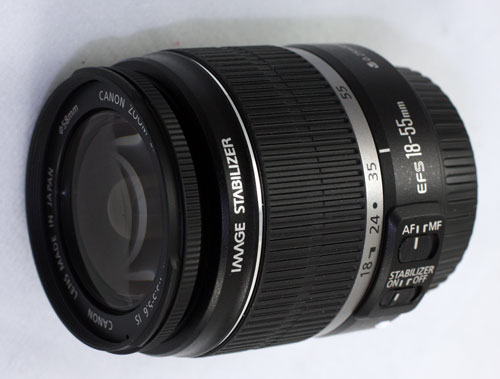
The first Canon 18-55mm lens was introduced with the 6MP Digital Rebel. At the time that lens was heralded as superb quality for a kit lens. The Digital Rebel is now in its fourth generation and resolution is doubled to 12.2MP. What was a great 6MP lens had become a not so wonderful 10MP lens on the XTi and it was time for an update with the move to 12MP.
Canon obliged with several minor changes to the 18-55mm layout and the addition of an aspherical element for one of the lenses. Canon has also developed a new simpler and lower-cost Image Stabilization system that is incorporated in the revised lens. While Optical Image Stabilization is built into lenses and only works with that IS lens it does offer the advantage of showing in the viewfinder, or on the Live View Screen, the true impact of the IS operation.
Mechanical Image Stabilization used by Sony, Pentax, and Olympus works with every lens you mount but you cannot see the effect through the viewfinder. However, recent implementations of Live View by these manufacturers allow the user in some cases to see the true effect of IS on Live View. Those are discussions for another article, but for now Canon, Nikon, and Panasonic have embraced Optical Image Stabilization.
Early testing shows the new 18-55mm IS to be a superb lens with performance comparable to top-line Canon lenses. Including an IS kit lens comes just in time as Sony, Pentax, and Olympus have all adopted mechanical IS built into the body in their entry cameras. Nikon is also offering an optical IS kit lens in their new D60.
Canon claims up to 4 stops of improved hand-holding with the new IS kit lens. We did find we could improve 2 to 3 stops in most situations, but the 4-stop advantage likely requires ideal conditions.
The most remarkable feature of the new IS lens, apart from quality images, is the price. Canon is including the 18-55mm IS for a premium of just $100 over the price of the body. Considering the real advantages of an optical IS lens it is definitely worth choosing the kit with the IS lens as it is $100 that is very well spent for the value received.
PC Remote Control
The prosumer 40D EOS utility software allows the user to remotely control the camera with your computer over a USB connection. This includes the option to record images directly to your hard disk. It was frankly a shock to see this same very Pro-oriented feature available now for the XSi. The utility now works on both the 40D and XSi and allows you to preprogram your PC or Mac for long exposures or for time-lapse photography. You can even focus and preview shots on the monitor in Live View mode.
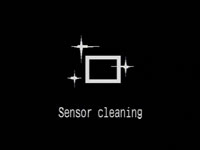
The EOS Integrated Cleaning System, first introduced on the Canon XTi, has been a feature of every Canon camera introduced since then. The system, which vibrates the sensor to shake off dust, is continued unchanged in the XSi.
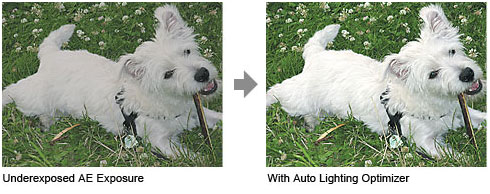
Auto Lighting Optimization is a new option on the XSi. This feature was introduced on the 40D. Canon claims the Auto Lighting Optimizer improves dynamic range and it is on by default. Therefore you can see the impact of ALO in our test images.

Those who prefer can turn off ALO in Custom Function 6. A related Custom Function 5 allows the user to enable/disable Highlight Tone Priority. This expands dynamic range from 18% grey to bright highlights. The downside is noise may increase in shadow areas. Both these dynamic range expansion features are brought over from the 40D. They work in PASM or A-DEP modes for JPEGs, but have no effect on images captured in RAW format.
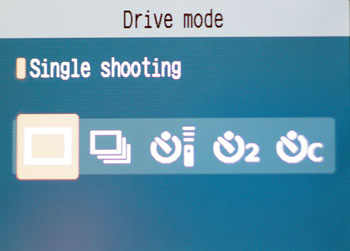
Continuous shooting is up to 3.5FPS, a slight increase from the 3FPS of the XTi despite the 20% increase in sensor resolution and image size. This makes the XSi one of the fastest entry DSLRs available in continuous mode. From the 40D the XSi also adds a 2 second timer mode (with optional mirror lockup) which is convenient for tripod shooting. The self-timer C option in the LCD screen shot above counts down from 10 seconds, but then takes a user selectable one to ten shots in succession to keep you from having to go back to the camera for second or third attempts.

The Rebel XSi is packaged in a big red splashy box for the US market. In Europe, where it is called the 450D, the packaging is a much more subtle Canon grey and black.
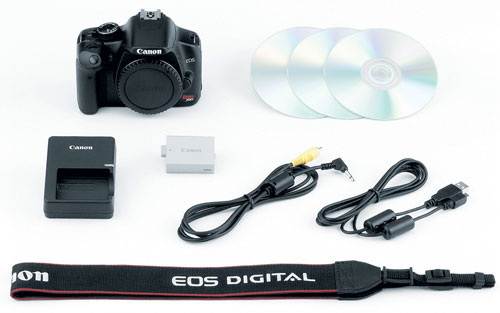
In the box you will find the rechargeable battery, charger, USB cable, video cable, Canon neck strap, software CDs, manuals, and warranty card(s). The most common kit with a lens includes the new 18-55mm f/3.5-5.6 IS (optical Image Stabilized) lens.










56 Comments
View All Comments
punchkin - Thursday, May 8, 2008 - link
So the upshot of it is that it is not PRESUMABLY rated at 50,000. You don't know, and pulled a number out of your butt.mikett - Wednesday, May 7, 2008 - link
Can anyone indicate the relative lifespan rating on the XSi vs the 40D?I once recalled that the 40D class ( 20D, 30D ) had a significantly higher rating than the Rebel class and their construction was sturdier but maybe that has changed.
mmusterd - Tuesday, May 6, 2008 - link
In fact in many ways the XSi is a much more exciting new camera than the 40D was when it was introduced just 6 months ago.Well, yes. It means the 40D is dropping in price, and op top of that, here in Europe, Canon is giving a substantial cashback om the 40D (of 150 euros). This means that the price difference between the 40D and 450D has practically vanished (at a randomly picked shop the 40D body now comes at 750 euros, whereas the same shop charges 660 euros for a 450d body).
This means that at about the same price (or at least a small premium) you can get the 40D instead of the 450D. Now tell me the reasons why I should buy the 450D instead.
For myself, I couldn't think of any, so I bought the 40D. For the article, in light of the very small current price difference, perhaps more thought could be given to the comparison between the two canons.
Wesley Fink - Tuesday, May 6, 2008 - link
You make a very good point. At the same price I would also select the 40D, but that is likely an anomaly due to the fact that the XSi was just introduced and its price is staying stubbornly at a higher price, while the 40D is now more than 6 months old. That pricing is certainly because resellers are having no problem selling the XSi at the higher price.We fully expect prices to settle down to a 20% to 40% price premium for the 40D. At that price difference it is easier to justify the XSi instead.
I do believe the size and weight of the XSi will appeal more to some users. Even with the grip the XSi is smaller and much easier to carry around all day than a 40D. Ergonomics are also the best so far from an entry Canon.
n4bby - Wednesday, May 7, 2008 - link
even with the improved ergonomics of the rebel, there is a huge advantage of the 40D: the scroll wheel control on the back. Canon uses this control on all their pro models as well and i cannot overstate what a huge usability difference this makes when you're shooting... i have the old 10D, and when i tried using a friend's rebel i was constantly frustrated by the tiny little cursor button controls on the back... when you're trying to quickly adjust your exposure on the fly it's hopelessly clumsy compared to the wheel. i seriously would pay $$ for that advantage alone.PokerGuy - Tuesday, May 6, 2008 - link
Wes, good work on this article. Most AT readers including myself are technically oriented and interested in all sorts of technology. We use cameras like the ones you review but we are not photography pros. Your kind of review is exactly what I like to see, not the ones done at the photo-pro kind of sites, those have a different target audience.Keep up the good work.
punchkin - Tuesday, May 6, 2008 - link
... and I don't mean it's aimed at third graders, either.kiii - Monday, May 5, 2008 - link
Thanks for another camera article Wesley, they are getting better and better.One thing that you have already touched on, but might want to investigate further are the noise reduction algorithms that different manufacturers use. For out of camera jpegs, Nikon tends to eliminate chrominance noise, while Canon leaves small amounts of chrominance noise. The result are small colored specs on high ISO Canon jpegs, while Nikon jpegs look more like "film grain". On the other hand, Sony seems to implement very aggressive (for DSLRs anyway) noise reduction in the a350, leading to the jagged edges you mentioned. Since this is AnandTech, there are definitely power users here and these users may want to shoot in raw. Perhaps for future DSLR reviews, you can do a raw comparison, using the same raw converter for all cameras. This way, you can bypass the camera's noise reduction and see the sensor's true performance. I know that the majority of first time DSLR users will not shoot in raw, but then again, not everyone overclocks their system either.
Either way, I did get a chance to play with the XSi myself, and it is quite the camera. I look forward to your XSi comparisons with the K20D and D300.
cray85 - Monday, May 5, 2008 - link
Your article mentions that the Sony A350 is better then the XSi at higher ISOs. However, your sample image is "too simple". A more challenging image (especially one with more in-focus low-contrast details) would clearly show the excessiveness of the noise-reduction routines employed by the A350. You'd then be able to see some significant smudging of the aforementioned low-contrast details and also some more of the jagged artifacts you mentioned.By contrast, the Canon and Nikon cameras employ a much more conservative approach. Noise is less of a problem at smaller print sizes but the detail loss due to heavy-handed noise reduction is an issue at all print sizes.
Also, while it's not a bad idea to compare the white balance accuracy of different cameras, sensitivity tests should always be performed with manually set white balance so that noise comparisons are consistent.
Finally, it's a good thing you've begun to stop your test lenses down to F4. However, an even better idea would be to use F8 to further increase the lens resolution and also to bring more details into focus.
I do understand the need for you to keep things simple for readers. However, this does not imply that cutting corners on crucial tests is acceptable. A beginner might decide to buy a Sony for reasons other then JPEG image quality. However, your testing should make clear the trade-offs he will have to make.
Wesley Fink - Monday, May 5, 2008 - link
I did NOT say the A350 was better at high ISO than the XSi. I said the A350 held up better than expected in comparison to the XSi. The A350 noise reduction was set to low in our image tests, and while the A350 is not superior, neither is it trounced by the Canon XSi or Nikon D60.At F8 and low ISO in our low-light tungsten setting the shutter speeds would be so low that we would create a new noise issue with long exposures. If we increased light to make F8 work better for the test range we would no longer be testing a typical interior lighting situation with high potential noise. We are not trying to determine noise in a studio lighting environment which would be a next to useless test for a typical XSi user.
F4 is a reasonable compromise that gets the f1.4 lenses in their best performance range without creating a new set of concerns that would skew the tests. Aperture is at F4 in all test shots.
I don't know too many amateurs who set manual white balance before shooting indoor available light. Most just leave it on Auto WB, but we know most of the DSLRs do a pretty poor job on Auto WB in Tungsten lighting. Our concession to that reality is to set the WB to Tungsten.
The user might know enough to set the WB to Tungsten for inside lamps and frankly the Canon is pretty awful in color balance even when we went to the trouble to set Tungsten WB. Nikon and Sony get it right under these conditions so we have to ask why Canon Tungsten WB is so biased to warm red. I think the poor Canon color in indoor Tungsten lighting is important info to provide to readers.